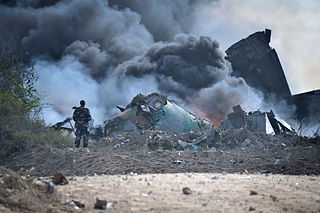
The Ilyushin Il-76 is a multi-purpose, fixed-wing, four-engine turbofan strategic airlifter designed by the Soviet Union's Ilyushin design bureau as a commercial freighter in 1967, to replace the Antonov An-12. It was developed to deliver heavy machinery to remote, poorly served areas. Military versions of the Il-76 have been widely used in Europe, Asia and Africa, including use as an aerial refueling tanker or command center.
This is a list of aviation-related events from 1993.
This is a list of aviation-related events from 1996:

The Antonov An-26 is a twin-engined turboprop civilian and military transport aircraft, designed and produced in the Soviet Union from 1969 to 1986.

The Embraer EMB 120 Brasilia is a twin-turboprop 30-passenger commuter airliner designed and manufactured by the Brazilian aircraft manufacturer Embraer.
TAE Avia, formerly named TransAVIAexport Airlines, is a Belarusian national cargo airline. It is based at Minsk International Airport in Belarus, with a hub at Sharjah International Airport, in the United Arab Emirates.

African Express Airways is a Somali-owned Kenyan airline with its head office at Jomo Kenyatta International Airport in Embakasi, Nairobi, Kenya.

Manas International Airport is the main international airport in Kyrgyzstan, located 25 kilometres (16 mi) north-northwest of the capital, Bishkek.

Aden Adde International Airport, formerly known as Mogadishu International Airport, is an international airport serving Mogadishu, the capital of Somalia. It is named after Aden Abdullah Osman Daar, the first President of Somalia.
This is a list of aviation-related events from 2007.

The Battle of Mogadishu began on 21 March 2007 in the Shirkole area of Mogadishu between Somali Transitional Federal Government forces and allied Ethiopian troops, and Islamist insurgents. The battle usually includes the dates, when referenced, in order to distinguish it amongst the nine major Battles of Mogadishu during the decades-long Somali Civil War.
Air ACT, legally ACT Airlines and formerly branded as myCargo Airlines, is a Turkish cargo airline based in Kurtköy, Istanbul. It operates international scheduled and charter air cargo services, as well as wet and dry lease services. Its main base is Sabiha Gökçen International Airport, Istanbul.

Tristar Air was an Egyptian cargo airline headquartered in Cairo with its base at Cairo International Airport.

On 6 July 2011, a Silk Way Airlines Ilyushin Il-76TD cargo aircraft on a flight from Baku, Azerbaijan, to Bagram Air Base in Afghanistan, crashed into a mountainside at an altitude of 3,800 metres (12,500 ft) while descending at night towards Bagram. All nine people on board were killed.
In aeronautics, loss of control (LOC) is the unintended departure of an aircraft from controlled flight and is a significant factor in several aviation accidents worldwide. In 2015 it was the leading cause of general aviation accidents. Loss of control may be the result of mechanical failure, external disturbances, aircraft upset conditions, or inappropriate crew actions or responses..

On 9 August 2013, an Antonov An-24 operated by the Ethiopian Air Force crashed while attempting to land at Aden Abdulle International Airport in Mogadishu, Somalia. There were six crew on board, of which four perished and two survived with injuries.

The Antonov An-12 is a transport aircraft designed and manufactured by the Ukrainian manufacturing and services company Antonov. Given the long operational history of the An-12, more than 190 An-12s have crashed involving many casualties. The An-12 has also been involved in a number of aviation incidents.

Daallo Airlines Flight 159 was a scheduled international passenger flight operated by Somali-owned Daallo Airlines. On 2 February 2016, an explosion occurred on board the aircraft 20 minutes after it took off from Mogadishu. The aircraft was able to return to the airport safely with one fatality. A subsequent investigation indicated that the explosion was caused by a bomb detonated in a suicide attack. The Islamist militant group Al-Shabaab claimed responsibility for the bombing. A total of ten people were convicted in relation to the plot.













